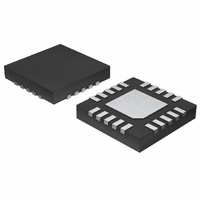MAX8790AETP+T Maxim Integrated Products, MAX8790AETP+T Datasheet - Page 20

MAX8790AETP+T
Manufacturer Part Number
MAX8790AETP+T
Description
IC LED DRVR WHITE BCKLGT 20-TQFN
Manufacturer
Maxim Integrated Products
Type
Backlight, White LEDr
Datasheet
1.MAX8790AETP.pdf
(23 pages)
Specifications of MAX8790AETP+T
Topology
PWM, Step-Up (Boost)
Number Of Outputs
6
Internal Driver
No
Type - Primary
Backlight
Type - Secondary
White LED
Frequency
1MHz
Voltage - Supply
4.5 V ~ 5.5 V, 5.5 V ~ 26 V
Voltage - Output
5V
Mounting Type
Surface Mount
Package / Case
20-TQFN Exposed Pad
Operating Temperature
-40°C ~ 85°C
Current - Output / Channel
27mA
Internal Switch(s)
Yes
Lead Free Status / RoHS Status
Lead free / RoHS Compliant
Efficiency
-
Lead Free Status / Rohs Status
Details
The input capacitor (C
from the input supply and reduces noise injection into
the IC. A 10µF ceramic capacitor is used in the typical
operating circuit (Figure 1) because of the high source
impedance seen in typical lab setups. Actual applica-
tions usually have much lower source impe-dance since
the step-up regulator often runs directly from the output
of another regulated supply. In some applications, C
can be reduced below the values used in the typical
operating circuit. Ensure a low noise supply at IN by
using adequate C
tion can be tolerated on C
using an RC lowpass filter.
Select C
thermal rise is less than approximately 10°C:
The series/parallel configuration of the LED load and the
full-scale bias current have a significant effect on regu-
lator performance. LED characteristics vary significantly
from manufacturer to manufacturer. Consult the respec-
tive LED data sheets to determine the range of output
voltages for a given brightness and LED current. In ge-
neral, brightness increases as a function of bias current.
This suggests that the number of LEDs could be
decreased if higher bias current is chosen; however,
high current increases LED temperature and reduces
operating life. Improvements in LED technology are
resulting in devices with lower forward voltage while
increasing the bias current and light output.
LED manufacturers specify LED color at a given LED
current. With lower LED current, the color of the emitted
light tends to shift toward the blue range of the spec-
trum. A blue bias is often acceptable for business appli-
cations but not for high-image-quality applications such
as DVD players. Direct DPWM dimming is a viable solu-
tion for reducing power dissipation while maintaining
LED color integrity. Careful attention should be paid to
switching noise to avoid other display quality problems.
Six-String White LED Driver with Active
Current Balancing for LCD Panel Applications
20
______________________________________________________________________________________
IN
’s RMS ripple current rating to ensure that its
IN
. Alternatively, greater voltage varia-
I
RMS
IN
Input Capacitor Selection
) filters the current peaks drawn
LED Selection and Bias
IN
=
2
if IN is decoupled from C
dI
×
L
3
IN
IN
Using fewer LEDs in a string improves step-up
converter efficiency, and lowers breakdown voltage
requirements of the external MOSFET and diode. The
minimum number of LEDs in series should always be
greater than the maximum input voltage. If the diode
voltage drop is lower than the maximum input voltage,
the voltage drop across the current-sense inputs (FB_)
increases and causes excess heating in the IC.
Between 8 and 12 LEDs in series is ideal for input volt-
ages up to 20V.
The MAX8790A has accurate (±1.5%) matching for
each current source. However, the forward voltage of
each white LED can vary up to ±5% from part to part.
The accumulated voltage difference in each string
equates to additional power loss within the IC. For the
best efficiency, the voltage difference between strings
should be minimized. The difference between lowest
voltage string and highest voltage string should be less
than 4.5V. Otherwise, the internal LED short-circuit pro-
tection shuts the part off.
Analog dimming mode allows lower peak LED current
and results in higher converter efficiency and lower
noise compared to direct DPWM mode. Unfortunately,
the LED color spectrum can shift as a function of DC
current so DPWM mode is often used to achieve more
consistent display characteristics. (See the LED manu-
facturer’s data sheet to determine the extent of the
color shift.) When the MAX8790A is configured with an
FSET resistor and CPLL capacitor, the ENA signal can
toggle between modes on the fly. Care should be exer-
cised when switching between modes to prevent the
current from becoming unstable during the PLL lock-in
time. To avoid such problems, force the controller into
DPWM mode between transitions.
Some LCD panels include a capacitor in parallel with
LED string to improve ESD immunity. The MAX8790A
can start up without a problem for string capacitance
up to 0.27µF.
Choosing the Appropriate Dimming Mode
Applications Information
LCD Panel Capacitance
LED V
FB_
Variation











